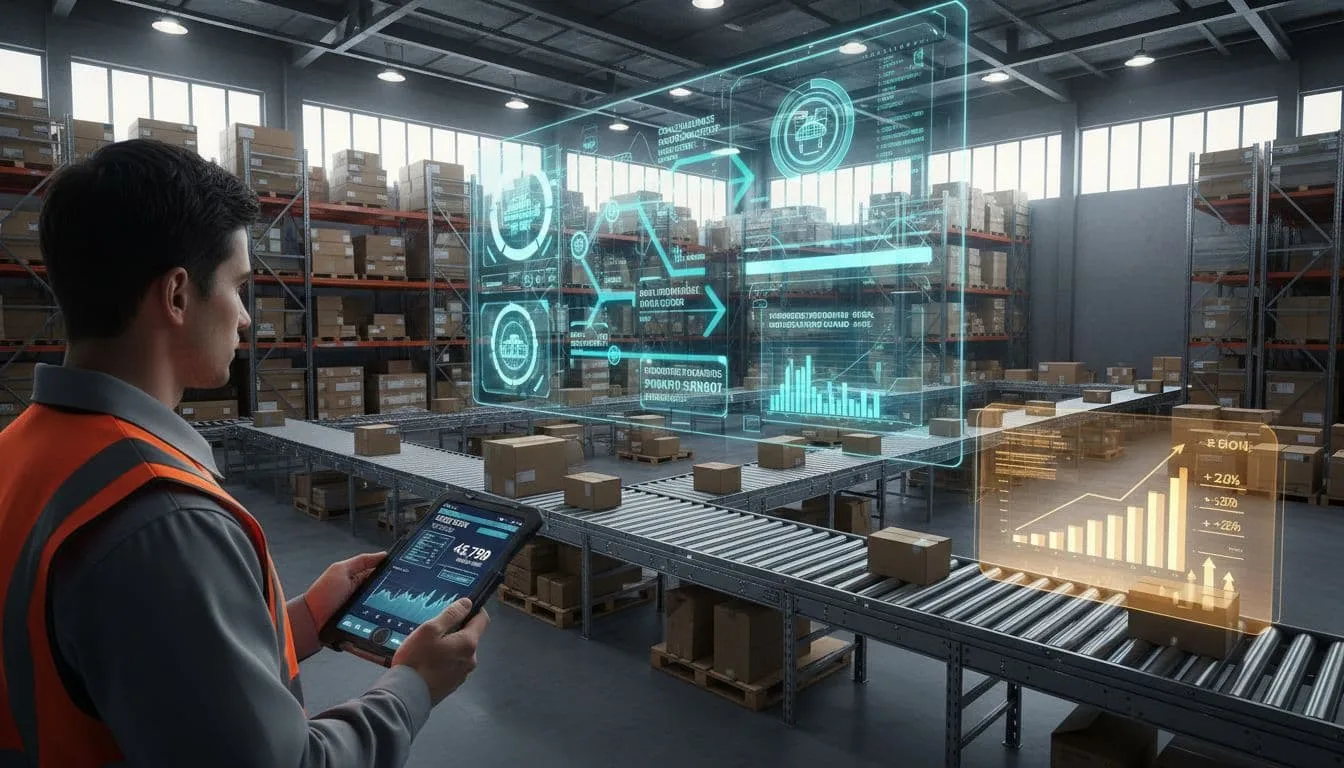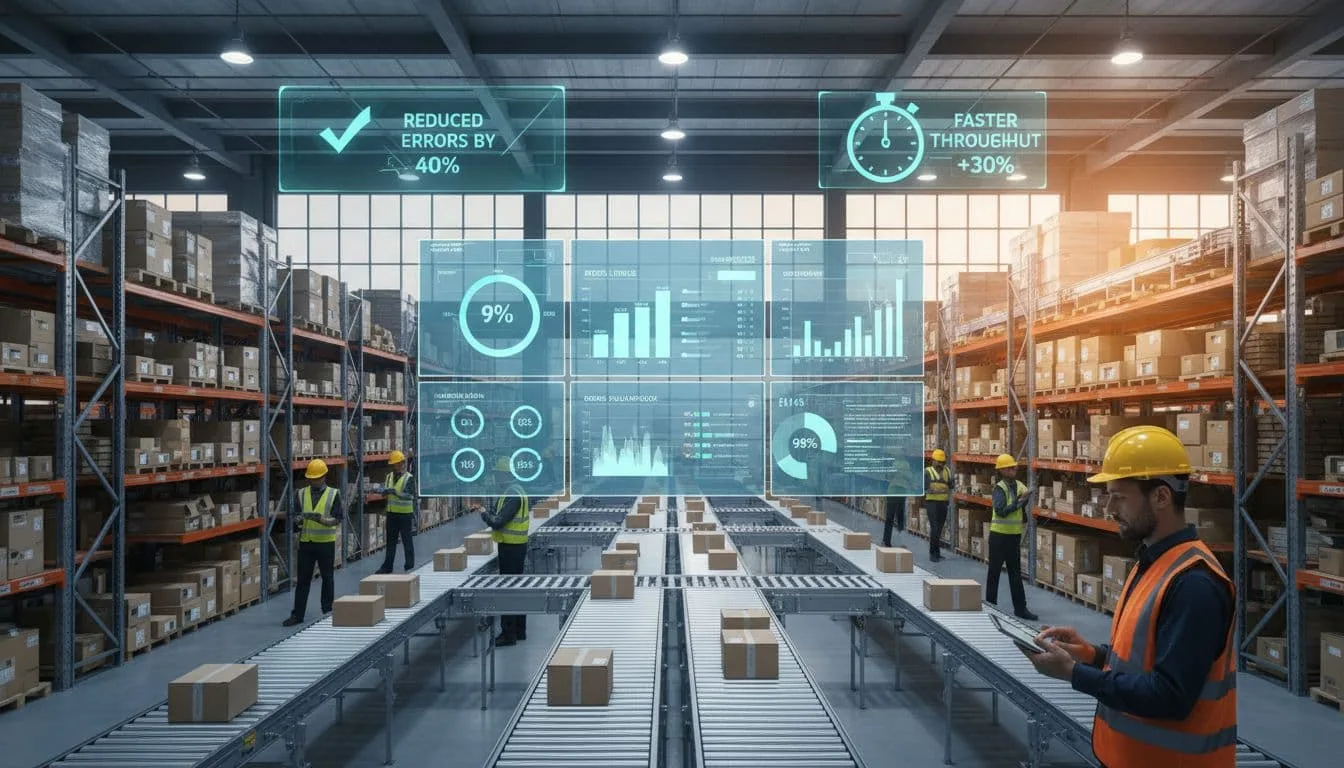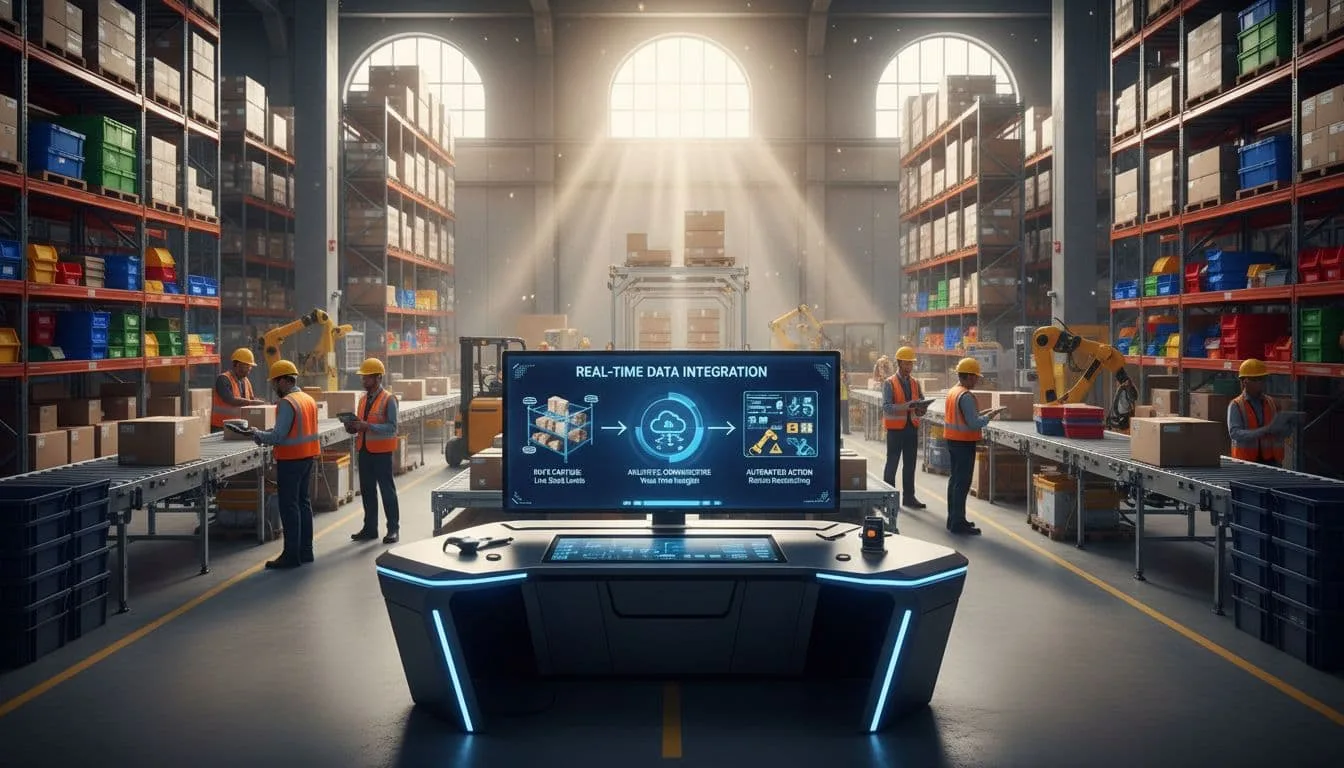Stale data turns a busy warehouse into chaos. Pickers wait for stock that is already gone, orders miss their window, and money leaks out of the schedule. You need live truth you can trust, not yesterday’s export.
That is where real time data in WMS comes in. In simple terms, it means your system updates the moment something happens, like a scan at receiving, a pick in aisle 12, or a carton leaving the dock. No batch files, no guessing, just live signals tied to inventory, orders, and tasks.
With real-time updates, you see what is in stock, what is reserved, and what is on the move, all on one screen. Forklifts, robots, and people work from the same source of truth, so routes, waves, and labor plans adjust on the fly. The result is faster picks, cleaner counts, fewer exceptions, and tighter carrier cutoffs.
This post will keep it practical. You will learn what real-time actually means in a WMS, how it works with scanners, RFID, IoT sensors, and APIs, and where AI and dashboards fit. We will break down the benefits you can measure, like order cycle time, dock-to-stock, inventory accuracy, and labor cost. You will also get a clear view of implementation steps, common roadblocks, and how to scale, plus a look at where things are headed with cloud, robotics, and predictive tools.
If you are comparing platforms, it helps to see how live tracking is built into modern tools. For a quick snapshot, check out this overview of a Smart WMS for Real-Time Tracking. It shows how live events tie directly into tasks, from receiving to shipping.
By the end, you will know what to expect from real-time features, what they need to run well, and how to plan your rollout. The goal is simple, fewer surprises, more control, and on-time orders at a lower cost. Let us replace lag with live data, and turn your floor into a steady, predictable operation.
What Exactly is Real-Time Data in a WMS?
Real-time data in WMS means the system captures and processes events the moment they happen. It tracks stock levels, item locations, order status, and worker tasks as they change. Think live sports scores on your phone, not waiting for highlights at night. With real-time data, a product scan on arrival updates inventory right away, reserves stock for an order, and queues the next task with no delay. Batch updates wait for a scheduled job, which creates blind spots and surprises on the floor.
Here is the simplest way to think about it: every receive, pick, move, and ship triggers an instant update. The WMS keeps a live ledger of everything, so there are no gaps between actions and the data you see. If you want a broader primer before the tech, skim this guide on Essential Features of WMS Including Real-Time Monitoring.
Key Components That Make Real-Time Tracking Possible
Real-time tracking is a tight loop of capture, stream, and display. Each piece plays a clear role.
- Barcode scanners: Handhelds and wearables scan items and locations in seconds. A scan at receiving, putaway, or pick sends the event directly to the WMS.
- RFID tags and readers: Readers detect tagged items as they pass gates or racks. This helps track cases and pallets without line-of-sight scanning.
- IoT sensors: Edge devices on docks, conveyors, and forklifts send location, movement, and presence data. You get automatic signals on arrivals, departures, and zone transfers.
- Streaming tools: Platforms like Apache Kafka move events in sequence with high speed. They handle thousands of signals per second, so no queue backs up.
- WMS software: The core app validates events, updates inventory, assigns tasks, and enforces rules. It writes every change to the ledger in real time.
- Live dashboards: Operators see counts, locations, and orders update on the spot. Exceptions pop up instantly, so teams act before a backlog forms.
Together, these components create a live feed of the warehouse. Every touch, move, and ship is captured, streamed, and shown without delay. The result is a complete, time-stamped trail of item movement with no gaps, which is the heart of real time data in WMS.
Top Benefits of Real-Time Data in WMS for Your Warehouse
When your team works from live signals, decisions get faster, errors drop, and operations run smooth. You spot bottlenecks early, fix issues before they snowball, and keep orders moving. The payoff shows up in inventory accuracy, cost control, and happier customers who trust your ETAs.
How It Boosts Inventory Accuracy and Cuts Costs
Instant updates stop the guesswork. Every receive, putaway, pick, and ship writes to the ledger the moment it happens. That single source of truth prevents double allocations, short picks, and phantom stock. During busy seasons, it keeps you from overselling a hot SKU or sitting on slow movers that eat space.
Here is where the savings stack up:
- Fewer write-offs: Live counts reduce mis-picks and lost inventory.
- Lower storage costs: Better visibility supports right-sized safety stock and smarter slotting.
- Faster turnover: You replenish what sells and pause what stalls, which tightens cash flow.
For teams connecting WMS with shopping carts, ERPs, and carriers, real-time sync cuts delays and handoff errors. If you want a deeper view of how integrations support live accuracy, check out How WMS integrations boost inventory accuracy. Tight integration helps keep counts aligned across systems, which means fewer stockouts and less overstock.
A quick example: an ecommerce brand sees a surge after a flash sale. With instant updates, the WMS reserves items in real time, shifts pick waves, and triggers replenishment. No backorders, no panic, just clean fulfillment.
Enhancing Customer Satisfaction Through Timely Updates
Customers judge you by what they see and when they get it. Real-time order tracking gives accurate ETAs, status changes, and delivery updates without support tickets. You reduce “where is my order?” messages because shoppers can see picks, packing, and ship confirmation as it happens.
This visibility also lifts the rest of the chain. Carriers get loads ready on time, support teams share the same live view, and sales knows what is truly available. When delays occur, early alerts let you reroute, split shipments, or offer options before disappointment sets in.
The result is simple: fewer surprises, faster fixes, and repeat buyers who trust your promises. When you pair timely updates with clean inventory data, you deliver what you sell, when you say you will. That is the core value of real time data in WMS.
How Does Real-Time Data Work Inside a WMS?
Think of real time data in WMS as a river that never stops. Events on the floor turn into signals that move through the system, get processed in milliseconds, and trigger the next best action. The flow is constant, clear, and shared with every person and system that needs it.
Here is the simple flow that keeps everything in sync:
- Event happens: A receive, pick, move, or ship occurs. A device detects it the instant it happens.
- Data is captured: Scans, RFID reads, and sensors record item IDs, locations, and counts.
- Data streams in: Events travel to the WMS through a high-speed pipeline. Tools like Kafka and Spark Streaming handle spikes and keep order.
- The WMS processes it: Rules validate the event, update inventory, and check task status. The system applies allocations and reservations right away.
- Actions trigger: Low stock alerts fire, replenishment tasks queue, and pick routes adjust. Automation can print labels, start packout, or create a transfer.
- Everyone sees it: Dashboards update at once. Supervisors track work-in-progress, and peers see the same live truth.
This loop powers the basics and the extras:
- Live inventory updates: The ledger reflects counts and locations in real time.
- Stock alerts: Thresholds trigger messages for reorder or bin checks.
- Order sync: ERP and ecommerce platforms get instant availability through APIs, so you avoid overselling and backorders.
- Exception handling: Short picks, blocked aisles, or late carriers raise alerts that route to the right team.
If you want to see how scanning tech supports this flow, this guide on How IoT and RFID Pair with QR Codes for Smarter Stock Control adds useful context.
The Role of Technology in Seamless Data Flow
Several tools keep the stream fast and reliable. RFID readers catch tagged pallets and cases without line of sight. Sensors on docks, conveyors, and trucks add location and movement signals that fill in the gaps. Cloud platforms scale to high volumes, absorb surges during peak, and add resilience with autoscaling and failover.
Event pipelines and stream processors, such as Spark Streaming, handle thousands of messages per second with low latency. They preserve order, filter noise, and batch micro-updates when needed. The result is high fidelity data, fewer retries, and a system that stays responsive even when orders spike.
Step-by-Step Guide to Implementing Real-Time Data in WMS
You can roll out real time data in WMS without stalling your floor. The key is a clear plan that fits your size, tech stack, and goals. Start with the work that moves the needle, then expand in short cycles. Keep each step visible, test with real users, and measure results before you scale.
- Define goals and metrics
- Set targets for accuracy, dock-to-stock, order cycle time, and pick rate.
- Map where delays happen today. Focus on the few workflows that cause most misses.
- Audit your warehouse and data sources
- List devices you already use, such as scanners, scales, RFID, and sensors.
- Note network coverage by zone. Spot dead spots and high-traffic areas.
- Select hardware and software that fit
- Pick scanners, readers, or wearables that your team will actually use.
- Confirm your WMS supports event streaming, APIs, and low-latency updates.
- Match tools to your scale. A smaller site can start with scanners and grow to RFID.
- Plan integrations early
- Sync with ERP, ecommerce, and TMS via stable APIs.
- Define a real-time source of truth for item, order, and location data.
- Use middleware if your ERP is older, so you avoid brittle point-to-point links.
- Train people, not just features
- Teach when to scan, what to scan, and how exceptions work.
- Use short, hands-on sessions by role. Reinforce with one-page job aids.
- Pilot, measure, improve, then scale
- Start in one area, like receiving or fast-moving picks.
- Track wins and issues for two to four weeks. Fix the gaps, then roll to the next area.
Overcoming Common Hurdles During Setup
Costs, integration, and training can slow momentum. Keep scope tight with a phased rollout, such as scanners first, then RFID in high-value zones. Control spend by reusing hardware where possible and focusing on priority SKUs. Reduce integration risk with clear data owners, a sandbox for testing, and API error alerts. For training, pair tool basics with process habits, like scan order and location checks. Short shifts with floor coaches help new users build confidence fast. With steady steps, real time data in WMS is a practical upgrade, not a giant leap.
Challenges, Solutions, and Future Trends for Real-Time WMS Data
Real time data in WMS pays off, but it comes with hurdles. Costs, integrations, data quality, change management, and scale all test your plan. Tackle each with a simple playbook and you can move fast without breaking the floor.
Here are the top challenges and practical fixes:
- High costs: Hardware, sensors, and licenses add up. Start with scanners and priority SKUs, then phase in RFID. Use a clear TCO model and budget for peak season traffic.
- Complex integrations: ERPs, carts, TMS, and robotics can get messy. Use stable APIs, a sandbox, and event-driven sync. Assign data owners and add alerting for failed messages.
- Data accuracy: Bad scans and drift ruin trust. Add required field checks, barcode validation, and cycle counts tied to exceptions. Track first-scan-to-post time to spot lag.
- Staff resistance: New steps slow people down at first. Run short role-based training, floor coaching, and simple job aids. Make wins visible, like fewer short picks and re-walks.
- Big data handling: Spikes flood the pipe. Use streaming queues, autoscaling, and retention rules. Archive raw events, keep hot aggregates in memory for live views.
Want a deeper look at where high-volume ops are heading with AI, IoT, cloud, and robotics? Review the 2025 trends in 3PL with IoT and cloud integration.
Emerging Trends Shaping the Future of Real-Time Data in WMS
AI and ML sharpen forecasting, slotting, and labor planning. Models merge orders, seasonality, and signals from sensors to predict demand and plan moves. They also drive predictive maintenance by spotting early signs of lift truck or conveyor issues, which cuts downtime.
IoT keeps expanding. More RFID, weight sensors, and location beacons fill gaps between scans. Wearables and heads-up displays give hands-free prompts and confirm steps on the spot. The result is cleaner data and safer work.
Cloud WMS brings elastic scale. Sites add capacity during peak, run multi-facility inventory as one pool, and roll features faster. Updates land often, which keeps latency low and reduces risk.
Automation gets smarter when it connects to live data. AMRs, AS/RS, and smart sorters adjust routes and waves in real time. If demand surges for a SKU, the system rebalances tasks, triggers replenishment, and shifts pick paths.
Analytics shift from reports to live decisions. Teams see at-risk orders, late carriers, and congested zones and act in minutes, not hours. In volatile markets, this speed turns chaos into clarity. The path forward is simple, connect signals, use AI for foresight, and scale with cloud and automation to stay responsive.
Conclusion
Real time data in WMS turns warehouse motion into clear, actionable signals. You get live inventory, faster cycle times, cleaner handoffs, and fewer surprises when orders spike. The workflow is simple, capture events, stream them at low latency, process with rules, and display insights everyone can use. The payoff shows up in order accuracy, dock-to-stock speed, labor efficiency, and stronger customer trust.
If your data lags or dashboards refresh slowly, this is your moment. Audit your scanners, network coverage, and integrations, then fix the highest-friction paths first. Pilot receiving or fast picks, measure the wins, and scale in short, safe steps. When you are ready to compare platforms that support live signals end to end, review the Best WMS Options for Real-Time Data Integration in 2025.
Stay focused on outcomes you can track, like at-risk orders, slotting accuracy, and first-scan-to-post time. Layer in automation and AI as volume grows, not before. The teams that act on live truth will outpace those who wait for reports. Start small, move fast, and keep your operation tuned for speed and clarity. Your warehouse will run tighter today, and be ready for what comes next.





